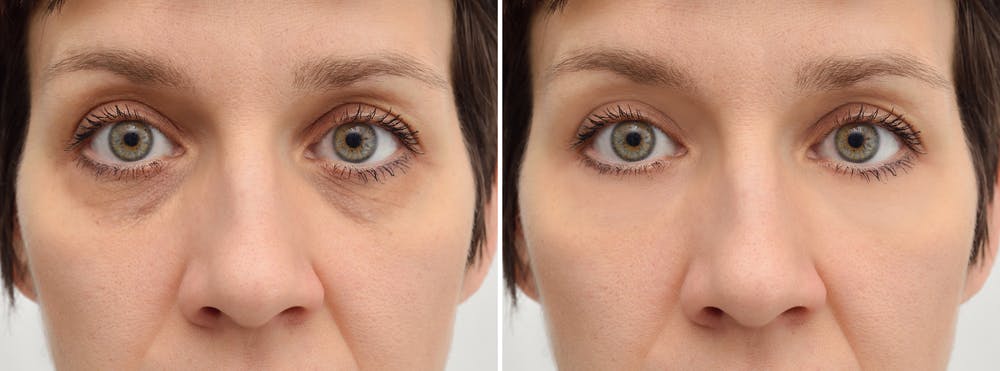
Have you ever wondered why some people considering facial enhancement opt for cosmetic eyelid surgery or blepharoplasty? This procedure can boost your natural beauty, but like any other surgical intervention, it carries potential complications, including surgical procedures. Our exploration into blepharoplasty, its purpose, preparation, common complications, and ways to manage risks provides essential insight. Stick around to learn from Glasgold Group experts on how patient recovery and education can enhance healing, minimize risks, and dramatically impact the psychological outcomes and long-term success of the procedure.
Common Complications After Blepharoplasty
After a blepharoplasty procedure, complications are not uncommon. Bleeding and infection can occur, though these are generally rare. More often, patients may experience uncomfortable symptoms such as itching, dry eyes, or watery eyes, which can sometimes lead to blurred vision. In some cases, swelling of the eyelids can persist longer than expected, affecting visual acuity.
Another typical post-procedure issue is difficulty closing the eye completely. This problem may result in exposure keratitis, a condition where the cornea is damaged due to excessive dryness, if not addressed promptly. In rare cases, the lower eyelids may turn outwards, creating a condition known as ectropion and affecting the patient’s appearance.
Lastly, changes in vision or even loss of vision are very rare but serious complications. While these complications are infrequent, they underline the importance of careful post-operative care and close communication with your healthcare provider in the days and weeks after the procedure, as vision loss is a significant concern.
Complications Involving the Eyelids
Post-surgery, certain complications involving the eyelids can occur. Excessive tearing, dryness, or irritation frequently result from changes to the eyelid’s shape or position. In severe cases, patients may suffer from ectropion, a condition where the eyelid turns outward, or entropion, where it turns inward. These conditions can impact the visual field and peripheral vision.
Irritation on the eye’s surface is another common issue due to changes in eyelid function. Should corrective surgery be required for these complications, it’s typically performed months after the initial blepharoplasty to allow the tissues sufficient healing time. Both patients and physicians should monitor the eyelids closely after surgery to prevent further complications, including double vision.
To minimize risks, both patients and medical professionals can adopt specific measures. For instance, the use of ointment and drops can alleviate dryness, while medical interventions can address more serious issues like ectropion and entropion. Revision surgery may be necessary in some cases.
For the most part, diligent post-operative care and observation can mitigate complications, reinforcing the importance of proper check-ups and follow-through with medical advice. Postoperative complications can often be managed effectively.
Managing Risks in Eyelid Surgery
One key strategy to manage risks in eyelid surgery is thorough preoperative evaluation. This involves assessing the patient’s overall physical health, understanding the anatomical structure of the eyelids, and setting realistic expectations. A careful patient selection process ensures the patient is an appropriate candidate for the procedure and helps to minimize risks of excess skin and upper eyelid issues.
Another critical factor is the surgical technique used. Skilled surgeons minimize trauma to the eyelids by using a precise and controlled approach. A well-planned procedure reduces the occurrence of complications such as hemorrhage, infection, and over-correction or under-correction of the eyelids, thereby enhancing patient outcomes and reducing the risk of complications.

The surgeon’s level of experience also significantly influences risk management. Experienced clinicians are adept at predicting and managing potential complications, thus reducing the likelihood of adverse events. Surgeons ensure they stay current with advances in the eyelid surgery field to ensure they employ the safest, most effective techniques. Choosing an oculoplastic surgeon can be particularly beneficial for addressing eye conditions.
Intraocular pressure during surgery is closely monitored to avoid complications, and light sensitivity is considered during the procedure. Intraoperative and postoperative care play a significant role in risk management. Surgeons must maintain meticulous aseptic techniques during the procedure to prevent infection. Additionally, providing the patient with clear postoperative instructions aids in their recovery and limits complications related to the eyelids.
Proper follow-up care is essential. It allows surgeons to identify any complications early and initiate appropriate interventions to mitigate the impact on the patient’s outcome. Regular follow-up visits facilitate continuous assessment of the healing process and enable the prompt resolution of any concerns related to the eyelids.
Role of Patient Education
A key component in managing the risks of eyelid surgery is the role of patient education. A comprehensive understanding of the procedure helps the patient navigate the recovery and minimizes the chance of complications. When patients know what to expect, they can prepare properly, follow instructions accurately, and react promptly to potential problems.
Importantly, it allows the patient to report abnormal signs timely, preventing minor issues from evolving into serious complications. Thus, through comprehensive pre-surgery preparation and thorough follow-up instructions, patient education significantly contributes to managing the risks of blepharoplasty and reducing the risk of complications.
A Patient Recovery Without Risks Following a Blepharoplasty

A successful patient recovery without risks following a blepharoplasty procedure involves careful preoperative evaluation and thorough postoperative instructions. Preoperatively, the surgeon must assess any excess skin or upper eyelid issues to minimize potential complications. During the procedure, light sensitivity should be considered as well as monitoring of intraocular pressure. Postoperatively, the patient should be aware that it may take several days for droopy eyelids and blurry vision to improve after eye surgery.
The patient should also be informed about any medical condition that may increase their risk of complications during the postoperative period and recovery from surgery. The surgeon should provide detailed instructions on how to care for the eyes after cosmetic surgery and inform them if any activities or medications can affect their healing process. Additionally, it is recommended for the patient to keep follow-up appointments with their surgeon to ensure proper healing without risks of complications associated with blepharoplasty.
Psychological Impact of Blepharoplasty Complications
When patients experience complications with Blepharoplasty, it is not uncommon for them to suffer emotional distress or psychological turmoil. The expectation of a better appearance leading to increased self-esteem can suddenly change into feelings of disappointment, fear, or even regret. This can trigger anxiety or depression, significantly impacting the patient’s psychological well-being.
The ability of a patient to bounce back from these psychological setbacks largely depends on their emotional resilience and the support system they have in place. It is also crucial for healthcare practitioners to competently manage complications and acknowledge the emotional struggles the patient might face, providing them with necessary psychological guidance.
Emotionally, patients with blepharoplasty complications might experience:
- Increased anxiety about their appearance
- Decreased self-esteem due to cosmetic dissatisfaction
- Feelings of regret or disappointment
- Fear of additional health complications
- Instances of social isolation due to their fear or embarrassment
Post Blepharoplasty: Long-term Care and Prevention of Further Complications
After blepharoplasty, patient care does not stop at initial healing but goes into long-term maintenance and future prevention. Ensure the treated area stays clean to avoid infection and maintain regular check-ups with your doctor.
Continued attention to overall eye health is critical. Preventative measures include avoiding straining the eyes, excess rubbing, and exposure to irritants. Sunglasses should be worn to protect against sun damage, while artificial tears can help keep eyes lubricated.
A balanced diet can also contribute to maintaining the health of the eyelid skin while staying hydrated is important for overall eye health.
Additionally, consider a routine of gentle eyelid exercises, after you get an all-clear from your doctor. These can maintain good blood circulation and muscle strength, preventing the recurrence of sagging or puffiness.
Ensuring a Successful Blepharoplasty Experience and Minimal Complications
Follow specific guidelines diligently to ensure a successful blepharoplasty procedure and minimal complications. First, select an experienced surgeon who specializes in this surgery on the eyelids. Assure your doctor comprehends your expectations and goals completely. Make sure to follow all pre- and post-surgery instructions meticulously for your safety and successful recovery. Remember, significant lifestyle adjustments like quitting smoking and refraining from alcohol can drastically improve your healing process. Your discipline with these instructions is vital to reducing complications, and it’s directly linked to the success of your blepharoplasty experience.
Get a thorough understanding and proper management of blepharoplasty complications from an expert. Nobody is better equipped to guide you than Dr. Mark Glasgold and Dr. Robert Glasgold who possesses extensive knowledge and experience in the field. Don’t compromise your well-being and beauty by resorting to guesswork. Schedule a consultation with Glasgold Group today and gain peace of mind knowing you are in capable hands. Your experience, safety, and satisfaction are our top priorities.



